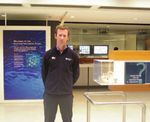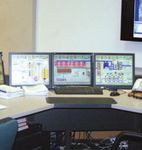Melbourne Water Eastern Treatment Plant - Connecting you to a more sustainable future
←
→
Page content transcription
If your browser does not render page correctly, please read the page content below
Case Study INDUSTRIAL Melbourne Water Eastern Treatment Plant Connecting you to a more sustainable future
Case Study / Melbourne Water Eastern Treatment Plant pg 2
Power from the people
The Eastern Treatment Plant, in Bangholme in Melbourne’s south-east, is a vital
part of Melbourne’s infrastructure. Operated by Melbourne Water, the plant
treats around 41 percent of Melbourne’s sewage and services roughly 1.5 million
people in Melbourne’s south-eastern and eastern suburbs.
In 2008/09 the plant treated an average of 312 million litres of sewage per day.
Some treated wastewater is recycled and the rest flows via the 57km South
Eastern Outfall pipeline to the Mornington Peninsula, where it is discharged into
Bass Strait at Boags Rocks, under an EPA Victoria licence.
When the Eastern Treatment Plant opened in 1975 it was a world leader in
the secondary treatment of sewage. Ongoing improvements to the plant over
the years have continued to serve the community well. Recently, a number
of upgrades at the plant have been/are being undertaken to ensure that
plant performance continues to meet community expectations. Two of these
developments involve the upgrade of the existing power station and the
construction of a new Odour Control Facility (OCF).
Part 1 – Power Station
Under a comprehensive plan titled the Eastern Green Energy Project (EGEP),
pumps that were previously powered by a combination of diesel and biogas
have been converted to run on electricity. Now the biogas – a by-product of the
plant, and which is 60 percent methane - provides the electricity for the pumps
by powering seven new generators.
The old engines, installed when the Eastern Treatment Plant was constructed
in 1975, consumed some 1.3 million litres of diesel per year. Eliminating diesel
usage in this way is the equivalent to removing about 600 diesel-powered cars
from the road.
Case Study / Melbourne Water Eastern Treatment Plant pg 3
By upgrading the existing power plant, which was used to power vital
equipment during maintenance and in the case of emergencies, the Eastern
Treatment Plant now produces 34.4GWh (gigawatt hours) of renewable electrical
energy from sewage each year. This is enough electricity to supply about 5,000
households, but is also about 40 percent of the total amount the plant needs to
function fully.
Through the use of technology, biogas is captured and harnessed to use as fuel
in seven modern spark ignition engines.
Melbourne Water Team Leader – Mechanical and Electrical Asset Management,
Julian Morton says: “The $46 million project reduces greenhouse gas emissions
in two ways – by reducing waste and by using renewable energy to power the
treatment processes.
“The revamped power station, commissioned in 2007, reduces electricity
imported from the grid by 34,400MWh per year and reduces greenhouse gas
emissions by about 40,800 tonnes a year,” he says.
Waste not …
Julian adds that EGEP is a key part of Melbourne Water’s pledge to reduce
net greenhouse gas emissions to zero by 2018. Melbourne Water is among
the top 20 energy users in the State, but has made significant inroads into
emissions reductions and renewable energy usage since 2000-01. Emissions are
significantly lower than the 2000-01 baseline.
“The modern equipment provides the opportunity to maximise the use of this
renewable energy source,” says Julian. “It also provides the heat energy for the
process to create biogas, in addition to the heating and cooling in buildings and
offices at the site year round.”
Powering ahead
“The control of the engines is to match the production of the biogas in the
process. The biogas is a fairly ‘dirty’ gas so maintenance of the engines is
paramount. After maintenance, the engines are started on natural gas and then
mixed across to biogas. This ensures the gas used by the engines does not
exceed the volume being produced by the process so that the system is always
at positive pressure,” says Julian.
“The EGEP power station provides positive outcomes for the environment
through the beneficial use of sewage and provides the plant with heat and
power. It is a key part of Melbourne Water’s commitment to sustainability and
our greenhouse emissions target.”
Case Study / Melbourne Water Eastern Treatment Plant pg 4
Fast facts
• 40,800 tonnes of CO2 eradicated;
• Creation of 34,400 megawatt hours of renewable electricity per year;
• More than 95 percent sludge gas utilised for power and heat, supplemented
with natural gas when required
• Eliminating 1.3 million litres of diesel per year;
• Over 100 billion litres of Class A recycled water produced for a range
of applications.
Part 2 – Odour control
A less than pleasant by-product of a sewage treatment plant is, naturally, the
odour. The Eastern Treatment Plant must meet environmental performance
targets that specify no offensive odours are to be discharged beyond the plant
boundary. “In 2009 a new Odour Control Facility (OCF) was commissioned at
the plant. The facility is the first of a three-stage strategy designed to achieve
significant odour reductions,” says Team Leader, ETP Planning, Colin Hughes.
“The new facility is a biofilter used to treat foul air from the incoming sewer
and inlet works. Prior to the new installation, the foul air was transferred to
extraction fans and vented without treatment.”
The biofilters, which rely on bacteria held in crushed bark for their success, are
able to reduce levels of hydrogen sulphide (the ‘rotten egg’ smell) from 24 parts
per million to just 0.1 parts per million.
A significant part of the new OCF included extensive electrical engineering and
contracting works and was undertaken by Nilsen. Founded in Victoria in 1916,
Nilsen remains a family-owned business to the fourth generation.
Works at the Eastern Treatment Plant included 24V DC control and monitoring of
odour control humidifiers and odour extraction fan motors.
It also included external lighting and general power around the new facility.
Case Study / Melbourne Water Eastern Treatment Plant pg 5
“Nilsen’s works at the Eastern Treatment Plant were carried out to our usual
level of technical excellence in equipment manufacturer, supply and installation.
“We knew that this new facility would have a positive impact on the environment
so we were proud to be involved,” says Project Manager Wayne English.
“One area where our technical expertise enhanced the project beyond the
contract’s specifications was that we built the switchboards rather than
purchasing them from a supplier,” he says.
“This enabled us to provide ready access to the experts in our switchboards
division to address technical questions and to discuss any potential or
perceived problems.
“If this service had been provided by a third party switchboard manufacturer,
there would have been significant additional costs,” he says.
Nilsen also carried out a range of low-level infrastructure engineering design
work around the new facility to meet the design intent of items such as control
panels, stands, and light poles/fittings.
Environment and energy-efficiency
As a business principle, Nilsen’s commitment to the environment and energy-
efficiency is a priority.
The company aims to minimise adverse environmental effects of its work by
using sustainable management processes and mitigation controls that comply
with the client, legislative and regulatory requirements.
“By using low current 24V DC monitoring and control equipment, not installing
excessive or unnecessary lighting and using the latest energy-efficient motors
we have helped reduce the plant’s carbon footprint.
“We also identified environmental risks associated with the delivery of the
works. We undertook and formulated strategies and processes to achieve low-
impact environmental outcomes,” says Wayne.
“All the equipment supplied complies with
the latest electrical standards and is fit-
for purpose.”
Wayne outlines that on the site construction
zone, separate bins for metal and cardboard
recycling and mixed bins for other types
of waste were provided. “Plus we recycled
our own copper wiring and cable drums,”
Wayne adds.
Case Study / Melbourne Water Eastern Treatment Plant pg 6
Scope of works
The works began with the modification of an existing main switchboard to
accommodate two new 2500A power supplies. These new supplies were
reticulated 250m from the existing switchroom in the chlorination building to
the new OCF, where the modern switchboards and Motor Logic Centres (MLCs),
which enable the operation of the new facility, would be housed.
Optic fibre and control cables were also extended from the existing network
control centre to the new facility to integrate it into the plant’s overall control
and monitoring network.
In the OCF, Nilsen installed five new switchboards of varying sizes,
manufactured in the company’s Heidelberg West plant. The switchboards
covered MLCs, PLCs (Programmable Logic Controls), VSDs (Variable Speed
Drives) and the main switchboard.
A 250kVA uninterrupted power supply (UPS) as back-up, power was
also installed.
Underground power and control cabling was installed to three humidifiers, five
biofilter odour foul air tanks, four 130kW extraction fans and the drainage
pumping station.
At each location, stainless steel control panels were installed for the termination
of incoming cables. “It’s important to use stainless steel as the harsh
environment of the plant corrodes mild steel,” says Wayne.
From these local control panels, the cables were installed to the pumps, motors,
and instruments.
“Once the installation of the equipment was completed, there was an extensive
commissioning process, where everything was tested and carefully integrated
into the existing systems and networks,” says Wayne.
“We then undertook some significant modifications to the new
switchboards, at Melbourne Water’s request, but still finished the
project on time.
“We believe that by installing the latest electrical equipment, combined
with our knowledge of energy efficiencies, we have provided the
Melbourne Water Eastern Treatment Plant with a sustainable solution to
its OCF,” he says, proudly.
“The use of quality products, the creation of our switchboards built
for the specific needs of this unique site and the implementation of
stainless steel fittings allows Melbourne Water to take full advantage of
its own power generation to run the OCF for many years to come.”
Case Study / Melbourne Water Eastern Treatment Plant pg 7
SUMMARY OF WORKS • Supply and installation of 2x 2500A busway electrical supplies for extension
UNDERTAKEN BY NILSEN of biofilter MLC control boards;
• Installation of underground sub-mains to new biofilter SAP building
control room;
• Manufacture and installation of control building main switchboards, PLC, MLC
and VSD switchboards;
• Supply and installation of underground services for the 4W treatment
switchboards and associated control cabling;
• Supply and installation of underground services for the site drainage
pumping station switchboard;
• Supply and installation of UPS in the biofilter control room;
• Installation of underground reticulation conduit system to the biofilter odour
foul air tanks;
• Supply and installation of all power and control cables to service the
instruments on the biofilter odour foul air tanks and humidifiers;
• Supply and installation of all exterior lighting for foul air tanks and
associated areas;
• Supply and installation of all stainless steel local control panels to service
instruments, motors and pumps’
• Supply and installation of optic fibre backbone and profibus
backbone system;
• Supply and installation of power cabling to 132kW exhaust extraction
fan motors;
• Supply and installation of general light and power to new control rooms;
• Complete commissioning of the new installation and integration into the
existing site network.
You can also read


























































